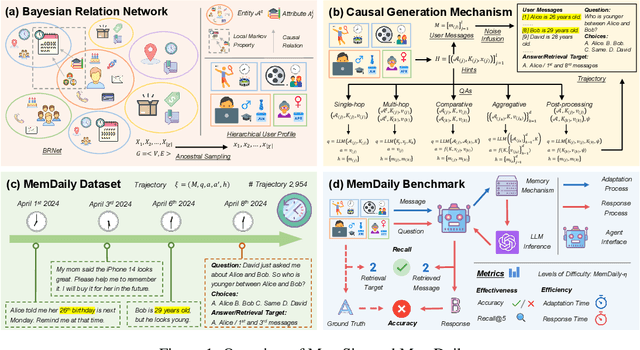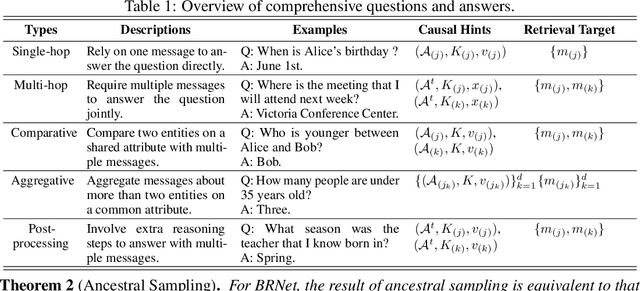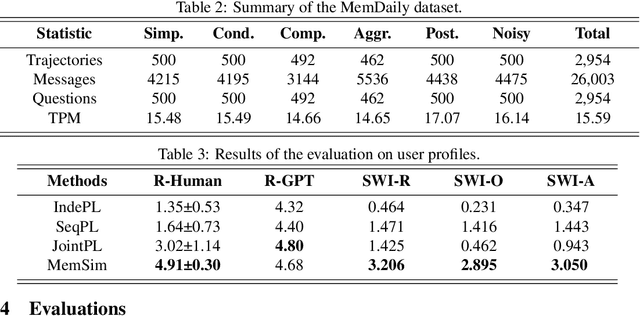Jieming Zhu
Vela: Scalable Embeddings with Voice Large Language Models for Multimodal Retrieval
Jun 17, 2025Abstract:Multimodal large language models (MLLMs) have seen substantial progress in recent years. However, their ability to represent multimodal information in the acoustic domain remains underexplored. In this work, we introduce Vela, a novel framework designed to adapt MLLMs for the generation of universal multimodal embeddings. By leveraging MLLMs with specially crafted prompts and selected in-context learning examples, Vela effectively bridges the modality gap across various modalities. We then propose a single-modality training approach, where the model is trained exclusively on text pairs. Our experiments show that Vela outperforms traditional CLAP models in standard text-audio retrieval tasks. Furthermore, we introduce new benchmarks that expose CLAP models' limitations in handling long texts and complex retrieval tasks. In contrast, Vela, by harnessing the capabilities of MLLMs, demonstrates robust performance in these scenarios. Our code will soon be available.
Device-Cloud Collaborative Correction for On-Device Recommendation
Jun 15, 2025Abstract:With the rapid development of recommendation models and device computing power, device-based recommendation has become an important research area due to its better real-time performance and privacy protection. Previously, Transformer-based sequential recommendation models have been widely applied in this field because they outperform Recurrent Neural Network (RNN)-based recommendation models in terms of performance. However, as the length of interaction sequences increases, Transformer-based models introduce significantly more space and computational overhead compared to RNN-based models, posing challenges for device-based recommendation. To balance real-time performance and high performance on devices, we propose Device-Cloud \underline{Co}llaborative \underline{Corr}ection Framework for On-Device \underline{Rec}ommendation (CoCorrRec). CoCorrRec uses a self-correction network (SCN) to correct parameters with extremely low time cost. By updating model parameters during testing based on the input token, it achieves performance comparable to current optimal but more complex Transformer-based models. Furthermore, to prevent SCN from overfitting, we design a global correction network (GCN) that processes hidden states uploaded from devices and provides a global correction solution. Extensive experiments on multiple datasets show that CoCorrRec outperforms existing Transformer-based and RNN-based device recommendation models in terms of performance, with fewer parameters and lower FLOPs, thereby achieving a balance between real-time performance and high efficiency.
EvdCLIP: Improving Vision-Language Retrieval with Entity Visual Descriptions from Large Language Models
May 24, 2025Abstract:Vision-language retrieval (VLR) has attracted significant attention in both academia and industry, which involves using text (or images) as queries to retrieve corresponding images (or text). However, existing methods often neglect the rich visual semantics knowledge of entities, thus leading to incorrect retrieval results. To address this problem, we propose the Entity Visual Description enhanced CLIP (EvdCLIP), designed to leverage the visual knowledge of entities to enrich queries. Specifically, since humans recognize entities through visual cues, we employ a large language model (LLM) to generate Entity Visual Descriptions (EVDs) as alignment cues to complement textual data. These EVDs are then integrated into raw queries to create visually-rich, EVD-enhanced queries. Furthermore, recognizing that EVD-enhanced queries may introduce noise or low-quality expansions, we develop a novel, trainable EVD-aware Rewriter (EaRW) for vision-language retrieval tasks. EaRW utilizes EVD knowledge and the generative capabilities of the language model to effectively rewrite queries. With our specialized training strategy, EaRW can generate high-quality and low-noise EVD-enhanced queries. Extensive quantitative and qualitative experiments on image-text retrieval benchmarks validate the superiority of EvdCLIP on vision-language retrieval tasks.
Revisiting Feature Interactions from the Perspective of Quadratic Neural Networks for Click-through Rate Prediction
May 23, 2025Abstract:Hadamard Product (HP) has long been a cornerstone in click-through rate (CTR) prediction tasks due to its simplicity, effectiveness, and ability to capture feature interactions without additional parameters. However, the underlying reasons for its effectiveness remain unclear. In this paper, we revisit HP from the perspective of Quadratic Neural Networks (QNN), which leverage quadratic interaction terms to model complex feature relationships. We further reveal QNN's ability to expand the feature space and provide smooth nonlinear approximations without relying on activation functions. Meanwhile, we find that traditional post-activation does not further improve the performance of the QNN. Instead, mid-activation is a more suitable alternative. Through theoretical analysis and empirical evaluation of 25 QNN neuron formats, we identify a good-performing variant and make further enhancements on it. Specifically, we propose the Multi-Head Khatri-Rao Product as a superior alternative to HP and a Self-Ensemble Loss with dynamic ensemble capability within the same network to enhance computational efficiency and performance. Ultimately, we propose a novel neuron format, QNN-alpha, which is tailored for CTR prediction tasks. Experimental results show that QNN-alpha achieves new state-of-the-art performance on six public datasets while maintaining low inference latency, good scalability, and excellent compatibility. The code, running logs, and detailed hyperparameter configurations are available at: https://github.com/salmon1802/QNN.
Benchmarking LLMs in Recommendation Tasks: A Comparative Evaluation with Conventional Recommenders
Mar 07, 2025Abstract:In recent years, integrating large language models (LLMs) into recommender systems has created new opportunities for improving recommendation quality. However, a comprehensive benchmark is needed to thoroughly evaluate and compare the recommendation capabilities of LLMs with traditional recommender systems. In this paper, we introduce RecBench, which systematically investigates various item representation forms (including unique identifier, text, semantic embedding, and semantic identifier) and evaluates two primary recommendation tasks, i.e., click-through rate prediction (CTR) and sequential recommendation (SeqRec). Our extensive experiments cover up to 17 large models and are conducted across five diverse datasets from fashion, news, video, books, and music domains. Our findings indicate that LLM-based recommenders outperform conventional recommenders, achieving up to a 5% AUC improvement in the CTR scenario and up to a 170% NDCG@10 improvement in the SeqRec scenario. However, these substantial performance gains come at the expense of significantly reduced inference efficiency, rendering the LLM-as-RS paradigm impractical for real-time recommendation environments. We aim for our findings to inspire future research, including recommendation-specific model acceleration methods. We will release our code, data, configurations, and platform to enable other researchers to reproduce and build upon our experimental results.
EAGER-LLM: Enhancing Large Language Models as Recommenders through Exogenous Behavior-Semantic Integration
Feb 20, 2025Abstract:Large language models (LLMs) are increasingly leveraged as foundational backbones in the development of advanced recommender systems, offering enhanced capabilities through their extensive knowledge and reasoning. Existing llm-based recommender systems (RSs) often face challenges due to the significant differences between the linguistic semantics of pre-trained LLMs and the collaborative semantics essential for RSs. These systems use pre-trained linguistic semantics but learn collaborative semantics from scratch via the llm-Backbone. However, LLMs are not designed for recommendations, leading to inefficient collaborative learning, weak result correlations, and poor integration of traditional RS features. To address these challenges, we propose EAGER-LLM, a decoder-only llm-based generative recommendation framework that integrates endogenous and exogenous behavioral and semantic information in a non-intrusive manner. Specifically, we propose 1)dual-source knowledge-rich item indices that integrates indexing sequences for exogenous signals, enabling efficient link-wide processing; 2)non-invasive multiscale alignment reconstruction tasks guide the model toward a deeper understanding of both collaborative and semantic signals; 3)an annealing adapter designed to finely balance the model's recommendation performance with its comprehension capabilities. We demonstrate EAGER-LLM's effectiveness through rigorous testing on three public benchmarks.
A Survey of Personalized Large Language Models: Progress and Future Directions
Feb 17, 2025Abstract:Large Language Models (LLMs) excel in handling general knowledge tasks, yet they struggle with user-specific personalization, such as understanding individual emotions, writing styles, and preferences. Personalized Large Language Models (PLLMs) tackle these challenges by leveraging individual user data, such as user profiles, historical dialogues, content, and interactions, to deliver responses that are contextually relevant and tailored to each user's specific needs. This is a highly valuable research topic, as PLLMs can significantly enhance user satisfaction and have broad applications in conversational agents, recommendation systems, emotion recognition, medical assistants, and more. This survey reviews recent advancements in PLLMs from three technical perspectives: prompting for personalized context (input level), finetuning for personalized adapters (model level), and alignment for personalized preferences (objective level). To provide deeper insights, we also discuss current limitations and outline several promising directions for future research. Updated information about this survey can be found at the https://github.com/JiahongLiu21/Awesome-Personalized-Large-Language-Models.
Progressive Collaborative and Semantic Knowledge Fusion for Generative Recommendation
Feb 10, 2025



Abstract:With the recent surge in interest surrounding generative paradigms, generative recommendation has increasingly attracted the attention of researchers in the recommendation community. This paradigm generally consists of two stages. In the first stage, pretrained semantic embeddings or collaborative ID embeddings are quantized to create item codes, aiming to capture and preserve rich semantic or collaborative knowledge within these codes. The second stage involves utilizing these discrete codes to perform an autoregressive sequence generation task. Existing methods often either overlook collaborative or semantic knowledge, or combine the two roughly. In this paper, we observe that naively concatenating representations from semantic and collaborative modality leads to a semantic domination issue, where the resulting representation is overly influenced by semantic information, effectively overshadowing the collaborative representation. Consequently, downstream recommendation tasks fail to fully exploit the knowledge from both modalities, resulting in suboptimal performance. To address this, we propose a progressive collaborative and semantic knowledge fusion model for generative recommendation, named PRORec, which integrates semantic and collaborative knowledge with a unified code through a two-stage framework. Specifically, in the first stage, we propose a cross-modality knowledge alignment task, which integrates semantic knowledge into collaborative embeddings, enhancing their representational capability. In the second stage, we propose an in-modality knowledge distillation task, designed to effectively capture and integrate knowledge from both semantic and collaborative modalities. Extensive experiments on three widely used benchmarks validate the effectiveness of our approach, demonstrating its superiority compared to existing methods.
An Automatic Graph Construction Framework based on Large Language Models for Recommendation
Dec 24, 2024Abstract:Graph neural networks (GNNs) have emerged as state-of-the-art methods to learn from graph-structured data for recommendation. However, most existing GNN-based recommendation methods focus on the optimization of model structures and learning strategies based on pre-defined graphs, neglecting the importance of the graph construction stage. Earlier works for graph construction usually rely on speciffic rules or crowdsourcing, which are either too simplistic or too labor-intensive. Recent works start to utilize large language models (LLMs) to automate the graph construction, in view of their abundant open-world knowledge and remarkable reasoning capabilities. Nevertheless, they generally suffer from two limitations: (1) invisibility of global view (e.g., overlooking contextual information) and (2) construction inefficiency. To this end, we introduce AutoGraph, an automatic graph construction framework based on LLMs for recommendation. Specifically, we first use LLMs to infer the user preference and item knowledge, which is encoded as semantic vectors. Next, we employ vector quantization to extract the latent factors from the semantic vectors. The latent factors are then incorporated as extra nodes to link the user/item nodes, resulting in a graph with in-depth global-view semantics. We further design metapath-based message aggregation to effectively aggregate the semantic and collaborative information. The framework is model-agnostic and compatible with different backbone models. Extensive experiments on three real-world datasets demonstrate the efficacy and efffciency of AutoGraph compared to existing baseline methods. We have deployed AutoGraph in Huawei advertising platform, and gain a 2.69% improvement on RPM and a 7.31% improvement on eCPM in the online A/B test. Currently AutoGraph has been used as the main trafffc model, serving hundreds of millions of people.
MemSim: A Bayesian Simulator for Evaluating Memory of LLM-based Personal Assistants
Sep 30, 2024



Abstract:LLM-based agents have been widely applied as personal assistants, capable of memorizing information from user messages and responding to personal queries. However, there still lacks an objective and automatic evaluation on their memory capability, largely due to the challenges in constructing reliable questions and answers (QAs) according to user messages. In this paper, we propose MemSim, a Bayesian simulator designed to automatically construct reliable QAs from generated user messages, simultaneously keeping their diversity and scalability. Specifically, we introduce the Bayesian Relation Network (BRNet) and a causal generation mechanism to mitigate the impact of LLM hallucinations on factual information, facilitating the automatic creation of an evaluation dataset. Based on MemSim, we generate a dataset in the daily-life scenario, named MemDaily, and conduct extensive experiments to assess the effectiveness of our approach. We also provide a benchmark for evaluating different memory mechanisms in LLM-based agents with the MemDaily dataset. To benefit the research community, we have released our project at https://github.com/nuster1128/MemSim.
 Add to Chrome
Add to Chrome Add to Firefox
Add to Firefox Add to Edge
Add to Edge